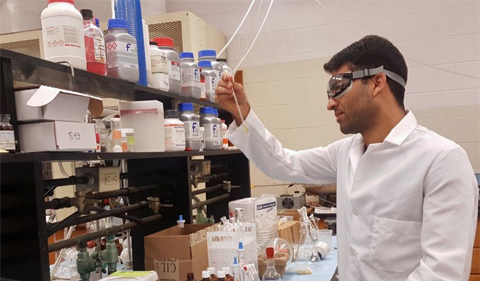
Chemistry doctoral student Ali Rafiei Miandashti is designing a thermosensing system that may one day be applied to cancer treatment. (Ramin Rabbani photo)
By Amanda Biederman
NQPI editorial intern
When it comes to developing more effective therapeutics for cancer, doctoral student Ali Rafiei Miandashti emphasizes the key is to think small.
Rafiei, who works under the supervision of Chemistry & Biochemistry professor and Nanoscale and Quantum Phenomena Institute member Dr. Hugh Richardson, is studying a nanoscale technology that may one day be used in cancer treatment.
Traditionally, chemotherapy is used in conjunction with radiation therapy to combat the growth of cancerous cells. A fundamental flaw of this approach is that the treatment also damages healthy cells. Photothermal therapy, a novel approach that employs the use of tiny plasmonic nanoparticles to heat cells at the nanoscale, may help to overcome this limitation.
In this approach, the nanoparticles are injected into the patient’s bloodstream, where they bind to cancer cells in the body. Next, the tissue is irradiated with a laser. This process causes the nanoparticles to generate heat, targeting the cancer cells while leaving healthy tissue intact. Photothermal therapy has been tested in animal models but has not yet been applied clinically, Rafiei said.
In a paper published recently in Nanoscale, Rafiei, recent Ph.D. alumnus Dr. Susil Baral, and Richardson characterized the absolute temperature and heat dissipation parameters from single gold metal nanoparticles. In this study, the team adhered gold metal nanoparticles on a photoluminescent film. The film functions as a thermosensor and detects the temperature, measured as the change in internal energy, of the nanoparticles.
Rafiei is now designing a system in which a second, larger nanoparticle is used as a substrate in place of the film. This approach, Rafiei said, is more applicable for clinical methods because it allows him to decrease the size of the system and measure temperature directly at the nanoparticles. The results of this study were published in MRS Advances last February with Richardson and Dr. Martin Kordesch, a Physics & Astronomy professor and NQPI member, as coauthors.
Rafiei said by understanding heat generation and decay from plasmonic nanoparticles, medical researchers will be able to advance the field of photothermal therapy.
“Much of our research is fundamental,” Rafiei said. “To optimize this new technique … it is important to understand how plasmonic nanoparticles behave in a biological system.”



















Comments